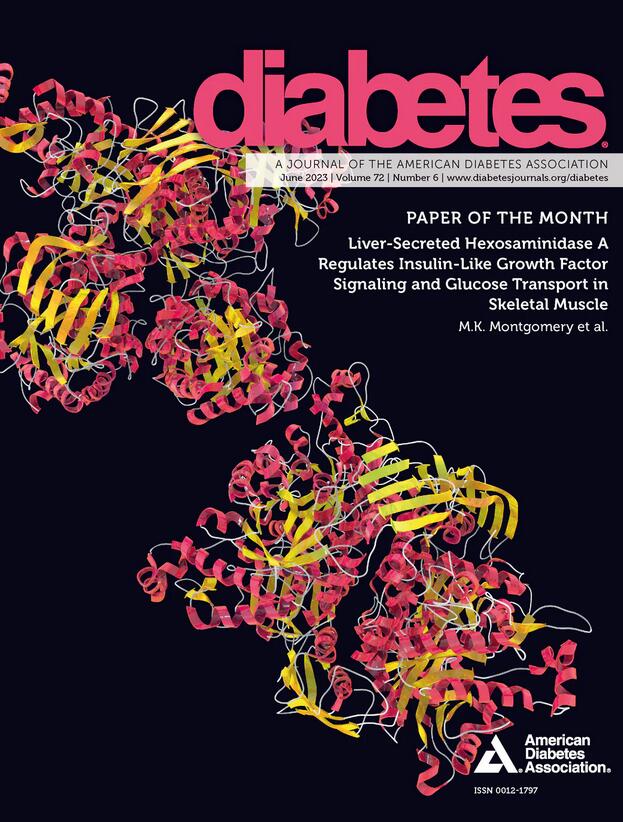1-hour postload glucose is a more sensitive marker of impaired β-cell function than 2-hour postload glucose
IF 6.2
1区 医学
Q1 ENDOCRINOLOGY & METABOLISM
引用次数: 0
Abstract
There is evidence that 1-h plasma glucose (PG) during the 75-g oral glucose tolerance test (OGTT) is superior to 2-h PG in predicting diabetes. We aimed to investigate the characteristics of insulin sensitivity and β-cell function behind this observation. After age, sex and BMI matching, 496 subjects selected from 3965 non-diabetic individuals at high risk of type 2 diabetes in a tertiary medical center were categorized into four groups in a 1:1:1:1 ratio based on OGTT results: 1) 1 h < 8.6 mmol/L and 2 h < 7.8 mmol/L (normal glucose tolerance [NGT] /1h-normal); 2) 1 h ≥ 8.6 mmol/L and 2 h < 7.8 mmol/L (NGT/1h-high); 3) 1 h < 8.6 mmol/L and 2 h ≥ 7.8 mmol/L (impaired glucose tolerance [IGT]/1h-normal); and 4) 1 h ≥ 8.6 mmol/L and 2 h ≥ 7.8 mmol/L (IGT/1h-high). Compared with subjects with IGT/1h-normal, those with NGT/1h-high exhibited similar extent of insulin resistance but lower early-phase insulin secretion. Additionally, participants with NGT/1h-high had lower disposition index at both 0-30 min and 0-120 min than those with IGT/1h-normal. The fitted regression line relating PG to log-transformed disposition index (0-30 min and 0-120 min) was significantly steeper for 1-h than 2-h PG. In conclusion, 1-h PG seemed to be more sensitive to the deterioration in β-cell function than 2-h PG. The use of 1-h PG may identify individuals at high risk of type 2 diabetes at an earlier stage与负荷后 2 小时葡萄糖相比,负荷后 1 小时葡萄糖是更灵敏的β细胞功能受损标志物
有证据表明,75 克口服葡萄糖耐量试验(OGTT)中的 1 小时血浆葡萄糖(PG)在预测糖尿病方面优于 2 小时血浆葡萄糖。我们旨在研究这一观察结果背后的胰岛素敏感性和β细胞功能特征。在年龄、性别和体重指数匹配后,我们从一家三级医疗中心的 3965 名 2 型糖尿病高风险非糖尿病患者中挑选了 496 名受试者,根据 OGTT 结果按 1:1:1:1 的比例将他们分为四组:1)1 h < 8.6 mmol/L和2 h < 7.8 mmol/L(正常糖耐量[NGT] /1h-正常);2)1 h ≥ 8.6 mmol/L和2 h < 7.8毫摩尔/升(NGT/1小时-高);3)1小时< 8.6毫摩尔/升,2小时≥7.8毫摩尔/升(糖耐量受损[IGT]/1小时-正常);4)1小时≥8.6毫摩尔/升,2小时≥7.8毫摩尔/升(IGT/1小时-高)。与IGT/1h-正常的受试者相比,NGT/1h-高的受试者表现出相似的胰岛素抵抗程度,但早期胰岛素分泌较低。此外,NGT/1h-高患者在 0-30 分钟和 0-120 分钟的处置指数均低于 IGT/1h-正常患者。PG 与对数转换处置指数(0-30 分钟和 0-120 分钟)之间的拟合回归线,1 小时 PG 明显比 2 小时 PG 更陡峭。总之,1 小时 PG 似乎比 2 小时 PG 对 β 细胞功能的恶化更敏感。使用 1-h PG 可以更早地识别出 2 型糖尿病的高危人群。
本文章由计算机程序翻译,如有差异,请以英文原文为准。
求助全文
约1分钟内获得全文
求助全文
来源期刊

Diabetes
医学-内分泌学与代谢
CiteScore
12.50
自引率
2.60%
发文量
1968
审稿时长
1 months
期刊介绍:
Diabetes is a scientific journal that publishes original research exploring the physiological and pathophysiological aspects of diabetes mellitus. We encourage submissions of manuscripts pertaining to laboratory, animal, or human research, covering a wide range of topics. Our primary focus is on investigative reports investigating various aspects such as the development and progression of diabetes, along with its associated complications. We also welcome studies delving into normal and pathological pancreatic islet function and intermediary metabolism, as well as exploring the mechanisms of drug and hormone action from a pharmacological perspective. Additionally, we encourage submissions that delve into the biochemical and molecular aspects of both normal and abnormal biological processes.
However, it is important to note that we do not publish studies relating to diabetes education or the application of accepted therapeutic and diagnostic approaches to patients with diabetes mellitus. Our aim is to provide a platform for research that contributes to advancing our understanding of the underlying mechanisms and processes of diabetes.
 求助内容:
求助内容: 应助结果提醒方式:
应助结果提醒方式:


